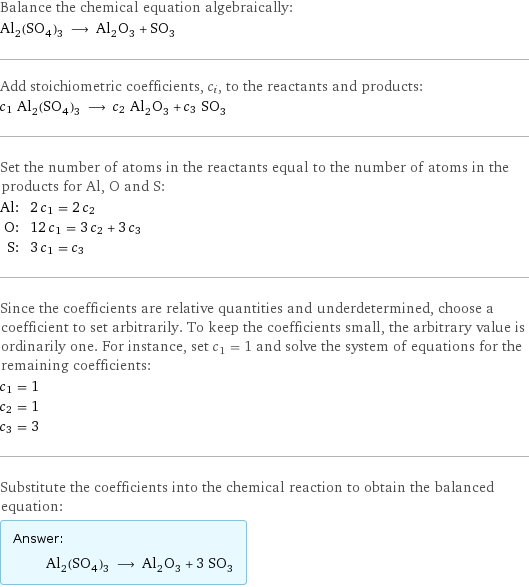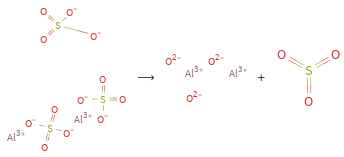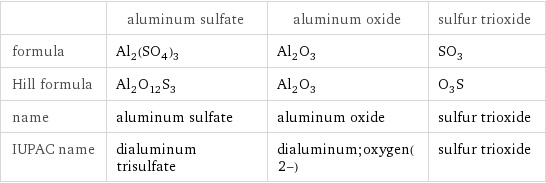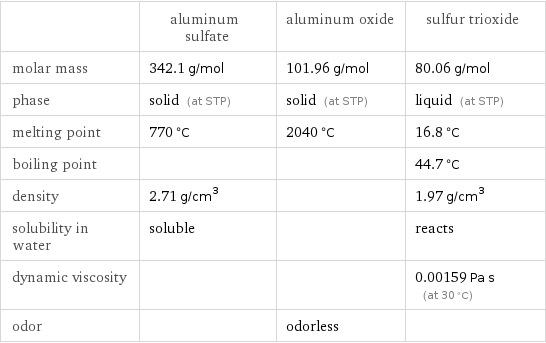Input interpretation

Al_2(SO_4)_3 aluminum sulfate ⟶ Al_2O_3 aluminum oxide + SO_3 sulfur trioxide
Balanced equation

Balance the chemical equation algebraically: Al_2(SO_4)_3 ⟶ Al_2O_3 + SO_3 Add stoichiometric coefficients, c_i, to the reactants and products: c_1 Al_2(SO_4)_3 ⟶ c_2 Al_2O_3 + c_3 SO_3 Set the number of atoms in the reactants equal to the number of atoms in the products for Al, O and S: Al: | 2 c_1 = 2 c_2 O: | 12 c_1 = 3 c_2 + 3 c_3 S: | 3 c_1 = c_3 Since the coefficients are relative quantities and underdetermined, choose a coefficient to set arbitrarily. To keep the coefficients small, the arbitrary value is ordinarily one. For instance, set c_1 = 1 and solve the system of equations for the remaining coefficients: c_1 = 1 c_2 = 1 c_3 = 3 Substitute the coefficients into the chemical reaction to obtain the balanced equation: Answer: | | Al_2(SO_4)_3 ⟶ Al_2O_3 + 3 SO_3
Structures

⟶ +
Names

aluminum sulfate ⟶ aluminum oxide + sulfur trioxide
Equilibrium constant
![Construct the equilibrium constant, K, expression for: Al_2(SO_4)_3 ⟶ Al_2O_3 + SO_3 Plan: • Balance the chemical equation. • Determine the stoichiometric numbers. • Assemble the activity expression for each chemical species. • Use the activity expressions to build the equilibrium constant expression. Write the balanced chemical equation: Al_2(SO_4)_3 ⟶ Al_2O_3 + 3 SO_3 Assign stoichiometric numbers, ν_i, using the stoichiometric coefficients, c_i, from the balanced chemical equation in the following manner: ν_i = -c_i for reactants and ν_i = c_i for products: chemical species | c_i | ν_i Al_2(SO_4)_3 | 1 | -1 Al_2O_3 | 1 | 1 SO_3 | 3 | 3 Assemble the activity expressions accounting for the state of matter and ν_i: chemical species | c_i | ν_i | activity expression Al_2(SO_4)_3 | 1 | -1 | ([Al2(SO4)3])^(-1) Al_2O_3 | 1 | 1 | [Al2O3] SO_3 | 3 | 3 | ([SO3])^3 The equilibrium constant symbol in the concentration basis is: K_c Mulitply the activity expressions to arrive at the K_c expression: Answer: | | K_c = ([Al2(SO4)3])^(-1) [Al2O3] ([SO3])^3 = ([Al2O3] ([SO3])^3)/([Al2(SO4)3])](../image_source/1e87044ac77251319ef923aaa5d897ec.png)
Construct the equilibrium constant, K, expression for: Al_2(SO_4)_3 ⟶ Al_2O_3 + SO_3 Plan: • Balance the chemical equation. • Determine the stoichiometric numbers. • Assemble the activity expression for each chemical species. • Use the activity expressions to build the equilibrium constant expression. Write the balanced chemical equation: Al_2(SO_4)_3 ⟶ Al_2O_3 + 3 SO_3 Assign stoichiometric numbers, ν_i, using the stoichiometric coefficients, c_i, from the balanced chemical equation in the following manner: ν_i = -c_i for reactants and ν_i = c_i for products: chemical species | c_i | ν_i Al_2(SO_4)_3 | 1 | -1 Al_2O_3 | 1 | 1 SO_3 | 3 | 3 Assemble the activity expressions accounting for the state of matter and ν_i: chemical species | c_i | ν_i | activity expression Al_2(SO_4)_3 | 1 | -1 | ([Al2(SO4)3])^(-1) Al_2O_3 | 1 | 1 | [Al2O3] SO_3 | 3 | 3 | ([SO3])^3 The equilibrium constant symbol in the concentration basis is: K_c Mulitply the activity expressions to arrive at the K_c expression: Answer: | | K_c = ([Al2(SO4)3])^(-1) [Al2O3] ([SO3])^3 = ([Al2O3] ([SO3])^3)/([Al2(SO4)3])
Rate of reaction
![Construct the rate of reaction expression for: Al_2(SO_4)_3 ⟶ Al_2O_3 + SO_3 Plan: • Balance the chemical equation. • Determine the stoichiometric numbers. • Assemble the rate term for each chemical species. • Write the rate of reaction expression. Write the balanced chemical equation: Al_2(SO_4)_3 ⟶ Al_2O_3 + 3 SO_3 Assign stoichiometric numbers, ν_i, using the stoichiometric coefficients, c_i, from the balanced chemical equation in the following manner: ν_i = -c_i for reactants and ν_i = c_i for products: chemical species | c_i | ν_i Al_2(SO_4)_3 | 1 | -1 Al_2O_3 | 1 | 1 SO_3 | 3 | 3 The rate term for each chemical species, B_i, is 1/ν_i(Δ[B_i])/(Δt) where [B_i] is the amount concentration and t is time: chemical species | c_i | ν_i | rate term Al_2(SO_4)_3 | 1 | -1 | -(Δ[Al2(SO4)3])/(Δt) Al_2O_3 | 1 | 1 | (Δ[Al2O3])/(Δt) SO_3 | 3 | 3 | 1/3 (Δ[SO3])/(Δt) (for infinitesimal rate of change, replace Δ with d) Set the rate terms equal to each other to arrive at the rate expression: Answer: | | rate = -(Δ[Al2(SO4)3])/(Δt) = (Δ[Al2O3])/(Δt) = 1/3 (Δ[SO3])/(Δt) (assuming constant volume and no accumulation of intermediates or side products)](../image_source/d057f4aa7552d17ac5856e4f5d92549c.png)
Construct the rate of reaction expression for: Al_2(SO_4)_3 ⟶ Al_2O_3 + SO_3 Plan: • Balance the chemical equation. • Determine the stoichiometric numbers. • Assemble the rate term for each chemical species. • Write the rate of reaction expression. Write the balanced chemical equation: Al_2(SO_4)_3 ⟶ Al_2O_3 + 3 SO_3 Assign stoichiometric numbers, ν_i, using the stoichiometric coefficients, c_i, from the balanced chemical equation in the following manner: ν_i = -c_i for reactants and ν_i = c_i for products: chemical species | c_i | ν_i Al_2(SO_4)_3 | 1 | -1 Al_2O_3 | 1 | 1 SO_3 | 3 | 3 The rate term for each chemical species, B_i, is 1/ν_i(Δ[B_i])/(Δt) where [B_i] is the amount concentration and t is time: chemical species | c_i | ν_i | rate term Al_2(SO_4)_3 | 1 | -1 | -(Δ[Al2(SO4)3])/(Δt) Al_2O_3 | 1 | 1 | (Δ[Al2O3])/(Δt) SO_3 | 3 | 3 | 1/3 (Δ[SO3])/(Δt) (for infinitesimal rate of change, replace Δ with d) Set the rate terms equal to each other to arrive at the rate expression: Answer: | | rate = -(Δ[Al2(SO4)3])/(Δt) = (Δ[Al2O3])/(Δt) = 1/3 (Δ[SO3])/(Δt) (assuming constant volume and no accumulation of intermediates or side products)
Chemical names and formulas

| aluminum sulfate | aluminum oxide | sulfur trioxide formula | Al_2(SO_4)_3 | Al_2O_3 | SO_3 Hill formula | Al_2O_12S_3 | Al_2O_3 | O_3S name | aluminum sulfate | aluminum oxide | sulfur trioxide IUPAC name | dialuminum trisulfate | dialuminum;oxygen(2-) | sulfur trioxide
Substance properties

| aluminum sulfate | aluminum oxide | sulfur trioxide molar mass | 342.1 g/mol | 101.96 g/mol | 80.06 g/mol phase | solid (at STP) | solid (at STP) | liquid (at STP) melting point | 770 °C | 2040 °C | 16.8 °C boiling point | | | 44.7 °C density | 2.71 g/cm^3 | | 1.97 g/cm^3 solubility in water | soluble | | reacts dynamic viscosity | | | 0.00159 Pa s (at 30 °C) odor | | odorless |
Units
